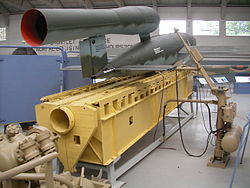V-1 flying bomb
The V-1 flying bomb (also called the Buzz Bomb or Doodlebug) was a World War II weapon.[3][4]
| V-1 flying bomb Fieseler Fi 103 Flakzielgerät 76 (FZG-76) | |
|---|---|
 | |
| Type | Guided missile |
| Place of origin | Nazi Germany |
| Service history | |
| In service | 1944–1945 |
| Used by | Luftwaffe |
| Wars | World War II |
| Production history | |
| Designer | Robert Lusser |
| Manufacturer | Fieseler |
| Unit cost | 5,090 RM[1] |
| Specifications | |
| Mass | 2,150 kg (4,740 lb) |
| Length | 8.32 m (27.3 ft) |
| Width | 5.37 m (17.6 ft) |
| Height | 1.42 m (4 ft 8 in) |
| Warhead | Amatol-39 |
| Warhead weight | 850 kg (1,870 lb) |
| Engine | Argus As 109-014 Pulse jet engine |
Operational range | 250 km (160 mi) [2] |
| Maximum speed | 640 km/h (400 mph) flying between 600 to 900 m (2,000 to 3,000 ft) |
Guidance system | Gyrocompass based autopilot |
It was a flying bomb, an early cruise missile. Its jet engine made it travel at 350 mph (600 kmph). The Luftwaffe aimed it at London, and also Antwerp in Belgium. V-1s destroyed nearly as many houses as the Blitz did but killed fewer: 22,892 people were killed by the weapon.
The Allies tried to stop these attacks by bombing their launching places, by shooting at them in the air, and by flying fast planes close to them and nudging them off course using their wings.
They had a fairly crude guidance system. Overall, only about 25 per cent of V-1s hit their targets. Most were lost lost by defensive measures, mechanical unreliability or guidance errors.
V-1 Flying Bomb Media
Rear view of V-1 in IWM Duxford, showing launch ramp section
A V-1 on display in the Musée de l'Armée, Paris
A reconstructed starting ramp for V-1 flying bombs, Historical Technical Museum, Peenemünde (2009)
V-1 on Walter catapult ramp at Éperlecques
On 13 June 1944, the first V-1 struck London next to the railway bridge on Grove Road, Mile End, which now carries this English Heritage blue plaque. Eight civilians were killed in the blast.
Related pages
References
| Wikimedia Commons has media related to Lua error in Module:Commons_link at line 62: attempt to index field 'wikibase' (a nil value).. |
- ↑ Zaloga, Steven 2005, p11. V-1 Flying Bomb 1942–52. Oxford, UK: Osprey Publishing. ISBN 978-1-84176-791-8
- ↑ Werrell, Kenneth P. 1985, p53. The Evolution of the Cruise Missile. Maxwell Air Force Base, Alabama: Air University Press
- ↑ Cooksley, Peter 1979. Flying Bomb, the story of Hitler's V-Weapons in World War II. New York: Charles Scribner's Sons.
- ↑ Haining, Peter 2002. The Flying Bomb War: contemporary eyewitness accounts of the German V1 and V2 raids on Britain 1942–1945. London: Robson Books. ISBN 978-1-86105-581-1








